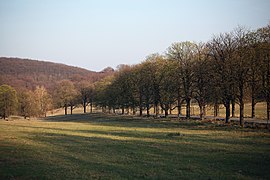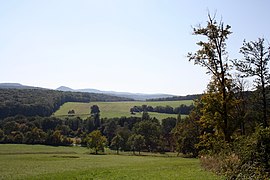Gütenbach (Vienna)
| Guttenbach | ||
|
Gütenbach in Kalksburg |
||
| Data | ||
| location | Vienna , Austria | |
| River system | Schwechat | |
| Drain over | Liesingbach → Schwechat → Danube → Black Sea | |
| source | in the Lainzer Tiergarten 48 ° 10 ′ 21 ″ N , 16 ° 11 ′ 13 ″ E |
|
| muzzle | in Kalksburg in the Liesingbach Coordinates: 48 ° 8 '12 " N , 16 ° 14' 29" E 48 ° 8 '12 " N , 16 ° 14' 29" E
|
|
| length | 6.9 km | |
| Catchment area | 8.7 km² | |
| Left tributaries | Kaisergraben | |
The Gütenbach is a brook in the Viennese districts Hietzing and Liesing . It is a feeder of the Liesingbach .
course
The Gütenbach is 6930 m long and has a gradient of 33 ‰. Its catchment area is 8.7 km².
The brook rises on the slopes of the Dreihufeisenberg in the Lainzer Tiergarten nature reserve in the 13th district of Hietzing. Its mostly dry feeders in the upper reaches are heavily ramified or stretched into narrow gorges. The Kerbtal of the upper reaches becomes a sole valley in the middle reaches , in which meanders form.
The Gütenbach leaves the Lainzer Tiergarten through a barred wall passage at the Gütenbachtor. It now runs through the forest and meadow area of the Kalksburg district of the 23rd district of Liesing, which is part of the Liesing landscape protection area. The Kaisergraben flows into the brook on the left. The second Viennese spring pipeline crosses the Gütenbach in a culvert . In its lower reaches the stream flows through populated areas. It leaves the flysch zone and reaches the Northern Limestone Pre-Alps . It finally flows into the Liesingbach on the left.
The Gütenbach carries water all year round. Its mean discharge (MQ) is 0.06 m³ / s. In the event of heavy rainfall, its water flow can increase suddenly. With a flood of the century (HQ100) 25.3 m³ / s are reached. At the Gütenbach there is a high, if not very high risk of flooding compared to Vienna. In the event of a flood of the century, infrastructure is affected to a lesser extent and the resident population is affected to a greater extent.
history
For the most part, no major human interventions were recorded for the Gütenbach. However, this does not apply to its mouth area. There was a weir here as early as the 18th century , where a mill stream was diverted. This Mühlbach led after its extension by means of an aqueduct over the Gütenbach. Around 1912 the Gütenbach was completely discharged into the Mühlbach with regular water flow. A straightening and hard construction of the estuary section, with a direct confluence with the Liesingbach, was realized by 2010. A renaturation of this section was completed in 2016. Among other things, the paving in the stream bed was removed, shallow water areas were set up and new trees were planted.
ecology
- Meadows in the Gütenbachtal
The Gütenbach is one of the most natural brooks in Vienna. A strip of alluvial forest , which is characterized by black alders , grows almost continuously on its banks . On the Dianawiese, ash trees and striking old hornbeams thrive on the banks of the stream . The Kaltbründlwiese has several spring outlets that feed trenches accompanied by cornices , reeds and marsh grass meadows . In the Kalksburger Gütenbachtal there are several rough meadows , including the extensive Eichwiese. In addition, 6 hectares of land are used for arable farming.
Numerous plant species grow in the Gütenbachtal in Kalksburg, which are strictly protected under the Vienna Nature Conservation Act:
- Small dogwort ( Anacamptis morio )
- Forest steppe anemone ( Anemone sylvestris )
- Actual Blackish Knapweed ( Centaurea nigrescens subsp. Nigrescens )
- Broad-leaf forest bird ( Cephalanthera damasonium )
- Crooked Hawthorn ( Crataegus rhipidophylla )
- True flesh fingerroot ( Dactylorhiza incarnata ssp. Incarnata )
- Spotted fingerroot ( Dactylorhiza maculata )
- Broadleaf fingerroot ( Dactylorhiza majalis )
- Wet meadow splendor carnation ( Dianthus superbus subsp. Superbus ); only occurrence in Vienna
- Austria Kranzian ( Gentianella austriaca )
- Mercy herb ( Gratiola officinalis )
- Large two-leaf ( Listera ovata )
- Pale Pyrenean stem Milchstern ( Loncomelos pyrenaicus subsp. Sphaerocarpus )
- Colorful pearl grass ( Melica picta )
- Crested grape hyacinth ( Muscari comosum )
- Avian aviary ( Neottia nidus-avis )
- Adder tongue ( Ophioglossum vulgatum )
- White forest hyacinth ( Platanthera bifolia )
- Southern lungwort ( Pulmonaria australis ); only occurrence in Austria
- Great Wiesenknopf ( Sanguisorba officinalis )
- Bog blue grass ( Sesleria uliginosa )
- Species group swamp dandelion ( Taraxacum palustre agg.)
- Medium flax leaf ( Thesium linophyllon )
- European globe flower ( Trollius europaeus )
- Silver cattails ( Typha shuttleworthii ); only occurrence in Vienna
- White Germer ( Veratrum album )
The purple forest bird ( Cephalanthera rubra ) in the Gütenbachgraben and the grass iris ( Iris graminea ) on the Gütenbachwiese also thrive in the Lainzer Tiergarten .
The following species belong to the bird world in the Kalksburger Gütenbachtal:
- Skylark ( Alauda arvensis )
- Corn Corn ( Crex crex )
- Quail ( Coturnix coturnix )
- Goldenhammer ( Emberiza citrinella )
- Reversible neck ( Jynx torquilla )
- Red- backed shrike ( Lanius collurio )
- Gray shrike ( Lanius excubitor )
- Feldschwirl ( Locustella naevia )
- Honey buzzard ( Pernis apivorus )
- Common redstart ( Phoenicurus phoenicurus )
- Gray woodpecker ( Picus canus )
- Starling ( Sturnus vulgaris )
- Hoopoe ( Upupa epops )
Skylark and Feldschwirl can also be found in the Gütenbachtal in the Lainzer Tiergarten.
In Gütenbachtal in Kalksburg living bat TYPES nymph bat ( Myotis alcathoe ), Bechstein's bat ( Myotis bechsteinii ) Noctule ( Nyctalus noctula ), Common Pipistrelle ( Pipistrellus pipistrellus ) and parti-colored bat ( Vespertilio murinus ). The amphibians native here include the yellow-bellied toad ( Bombina variegata ), the common toad ( Bufo bufo ), the tree frog ( Hyla arborea ) and the common frog ( Rana temporaria ). Of snakes that are smooth snake ( Coronella austriaca ) and the Äskulapnatter ( Zamenis longissimus ) to find. The grasshoppers in the Kalksburger Gütenbachtal include the great plump insect ( Isophya modestior ), the belly insect ( Polysarcus denticauda ), the southern shrub insect ( Pholidoptera fallax ) and the mole cricket ( Gryllotalpa gryllotalpa ).
The Gütenbach in the Lainzer Tiergarten is a habitat for dragonflies TYPES Great source of honor ( Cordulegaster heros ) and ringed Bridesmaid ( Cordulegaster bidentata ). In a study mid-1980s were stone crabs ( Austropotamobius torrentium ) and the fish species trout , minnow , loach and Koppe detected in the stream.
bridges
The Gütenbach is crossed by the following bridges, lined up in the direction of flow:
- Sailergraben Bridge at Dianawiese: The 8 m long and 5 m wide road bridge on Hirschgstemmstraße was built in 1940.
- Elisabeth Bridge: The 6 m long and 6 m wide reinforced concrete road bridge of the Schlossergassl was built in 1940.
- Gütenbachbrücke I: The 3 m long and 5 m wide reinforced concrete road bridge on Gütenbachstrasse was built in 1940.
- Gütenbach Bridge II: The 5 m long and 5 m wide reinforced concrete road bridge on Gütenbachstrasse was built in 1940.
- Gütenbachsteg: The 4 m long and 2 m wide wooden pedestrian bridge was built in 2001.
- Gütenbachtorbrücke: The 8 m long and 6 m wide reinforced concrete road bridge at the Gütenbachtor of the Lainzer Tiergarten was built in 1960.
- Pfaffenspitzbrücke at the Jägerhaus tavern: the 6 m long and 4 m wide road bridge made of reinforced concrete was built in 1959.
- Jägerwegbrücke: The 11 m long and 6 m wide reinforced concrete road bridge on Jägerweggasse was built in 1957.
- Gütenbach Bridge: The 10 m long and 13 m wide reinforced concrete road bridge on Breitenfurter Strasse was built in 1946.
See also
literature
- Julia Tanzer: Historical morphological changes in the southern Viennese Danube feeder 1755–2010 . Master thesis. University of Natural Resources and Life Sciences, Vienna 2016, Chapter 5.3.3 Gütenbach , p. 81-84 ( boku.ac.at [PDF]).
Web links
Individual evidence
- ^ A b c Julia Tanzer: Historical morphological change in the southern Viennese Danube feeder 1755-2010 . Master thesis. University of Natural Resources and Life Sciences, Vienna 2016, p. 84 ( boku.ac.at [PDF; accessed January 3, 2020]).
- ^ A b Julia Tanzer: Historical morphological changes in the southern Viennese Danube feeder 1755-2010 . Master thesis. University of Natural Resources and Life Sciences, Vienna 2016, p. 81–82 ( boku.ac.at [PDF; accessed January 3, 2020]).
- ↑ MA 45, review of the discharge capacity of various torrents in connection with flood protection. Activity report 2014. (PDF) City Audit Office Vienna, April 2014, p. 7 , accessed on January 3, 2020 .
- ↑ New relaxation room on the Gütenbach. Vienna Waters (Municipal Department 45), accessed on January 20, 2020 .
- ↑ Johanna Scheiblhofer, Wolfgang Schranz: Diverse Nature in Liesing. (PDF) Biosphärenpark Wienerwald Management GmbH, October 2019, pp. 102–102 , accessed on January 3, 2020 .
- ↑ Johanna Scheiblhofer, Wolfgang Schranz: Diverse nature in Hietzing. (PDF) Biosphärenpark Wienerwald Management GmbH, December 2019, pp. 95–111 , accessed on January 3, 2020 .
- ↑ Johanna Scheiblhofer, Wolfgang Schranz: Diverse Nature in Liesing. (PDF) Biosphärenpark Wienerwald Management GmbH, October 2019, pp. 36 and 78 , accessed on January 3, 2020 .
- ↑ Johanna Scheiblhofer, Wolfgang Schranz: Diverse Nature in Liesing. (PDF) Biosphärenpark Wienerwald Management GmbH, October 2019, pp. 120–122 , accessed on January 3, 2020 .
- ↑ Johanna Scheiblhofer, Wolfgang Schranz: Diverse nature in Hietzing. (PDF) Biosphärenpark Wienerwald Management GmbH, December 2019, pp. 129–130 , accessed on January 3, 2020 .
- ↑ Johanna Scheiblhofer, Wolfgang Schranz: Diverse Nature in Liesing. (PDF) Biosphärenpark Wienerwald Management GmbH, October 2019, pp. 135, 143–150 , accessed on January 3, 2020 .
- ↑ Johanna Scheiblhofer, Wolfgang Schranz: Diverse nature in Hietzing. (PDF) Biosphärenpark Wienerwald Management GmbH, December 2019, p. 156 , accessed on January 3, 2020 .
- ↑ Johanna Scheiblhofer, Wolfgang Schranz: Diverse Nature in Liesing. (PDF) Biosphärenpark Wienerwald Management GmbH, October 2019, pp. 125–126 , accessed on January 3, 2020 .
- ↑ Johanna Scheiblhofer, Wolfgang Schranz: Diverse Nature in Liesing. (PDF) Biosphärenpark Wienerwald Management GmbH, October 2019, pp. 128 and 131 , accessed on January 3, 2020 .
- ↑ Johanna Scheiblhofer, Wolfgang Schranz: Diverse Nature in Liesing. (PDF) Biosphärenpark Wienerwald Management GmbH, October 2019, pp. 153–156 , accessed on January 3, 2020 .
- ↑ Johanna Scheiblhofer, Wolfgang Schranz: Diverse Nature in Liesing. (PDF) Biosphärenpark Wienerwald Management GmbH, October 2019, pp. 159–160 , accessed on January 3, 2020 .
- ↑ Johanna Scheiblhofer, Wolfgang Schranz: Diverse Nature in Liesing. (PDF) Biosphärenpark Wienerwald Management GmbH, October 2019, pp. 162, 164–165 , accessed on January 3, 2020 .
- ↑ Heidemarie Lang, Christoph Lang, Rainer Raab: Recording the spring maiden occurrences in Vienna's urban area . In: Environmental Protection, Magistrat der Stadt Wien (Ed.): Studies by the Vienna Environmental Protection Department (MA 22) . December 2002, p. 7 ( PDF on ZOBODAT [accessed January 3, 2020]).
- ↑ Wolfgang Bittermann: The stone crab Austropotamobius torrentium in Vienna . In: Stapfia . No. 58 , 1998, pp. 30–31 ( PDF on ZOBODAT [accessed January 3, 2020]).
- ↑ Bridge Information Vienna. Vienna Bridge Construction and Foundation Engineering (Municipal Department 29), Municipal Authority of the City of Vienna, accessed on January 3, 2020 .






